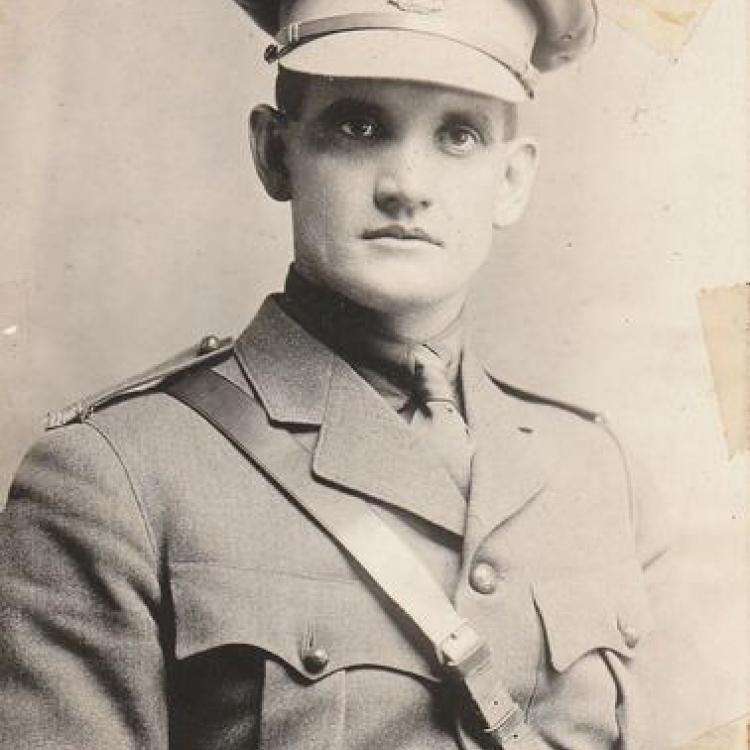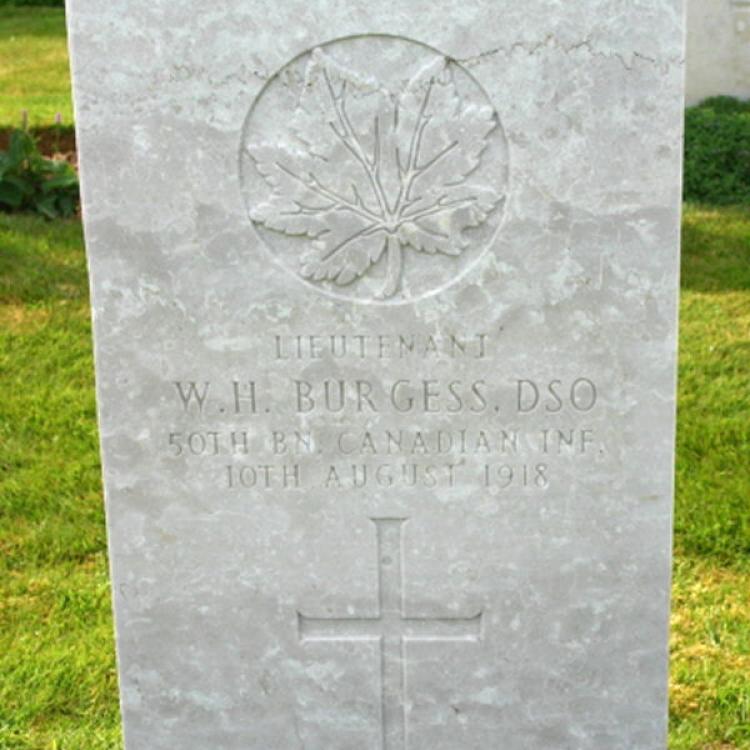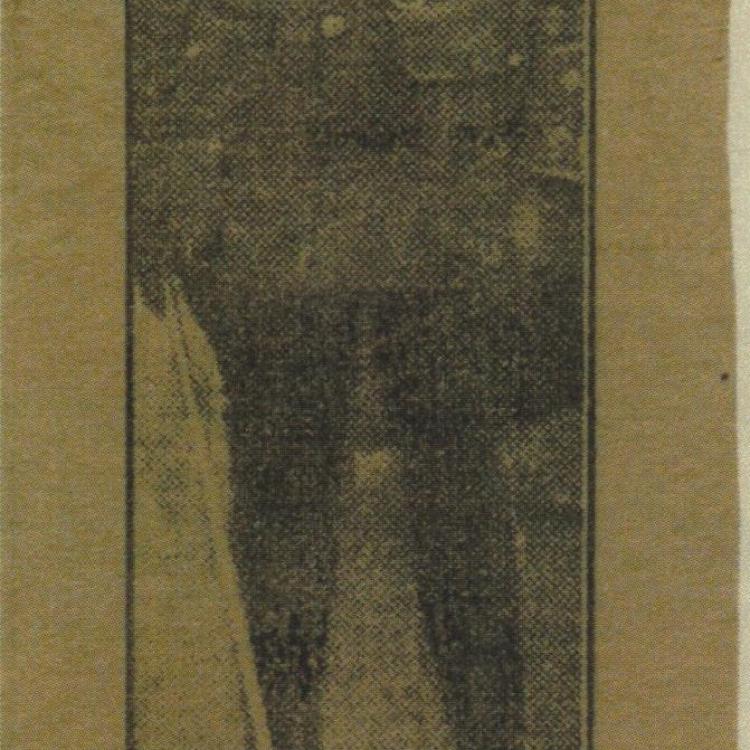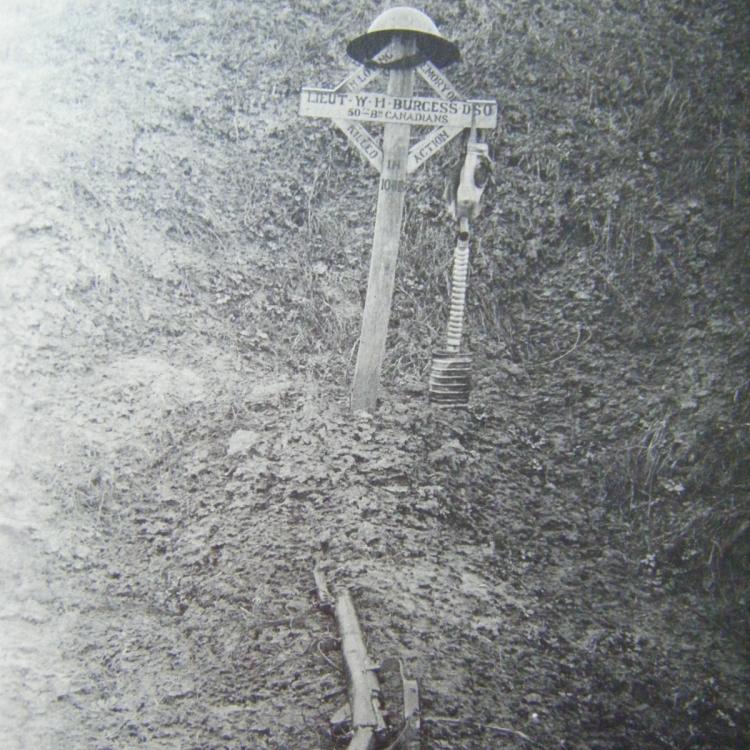BURGESS, Walter Hartley
Next of Kin: Mrs. John Burgess, Bluevale, Ontario
Occupation: Clerk in General Store
Personal Details: 5 ft. 7 ½ in., 156 lbs., dark complexion, dark eyes, dark hair, Presbyterian
Death: August 10, 1918, buried Fouquescourt British Cemetery, France
Awards: Distinguished Service Order
Walter was the youngest son of John and Elizabeth Burgess. They were Scottish immigrants who farmed on the 1st line of Morris Township for some years before moving their family into the Village of Bluevale. John served as the town clerk for many years, and helped establish the Bluevale Cheese and Butter Company where several of his sons, including Walter, were employed. In late 1900, Walter left the cheese factory for a position at Kerr’s, a dry goods and grocery store in Wingham. In the late summer of 1904, Walter was one of several area youth who left on a harvest excursion to Western Canada. When he returned two months later he secured employment at Ball Brothers, Wingham, where he learned the furniture and undertaking business. In May 1906, Walter left for Moosomin, Saskatchewan, where he and another local, Herbert Henry Wightman, were to become partners in their own gents’ furnishings, boot, shoe and grocery business.
On January 6, 1916, Walter enlisted with the 229th Battalion (South Saskatchewan) at Wolseley, Saskatchewan, where he was living and working as a clerk in a general store. In April 1916, Private Burgess was transferred to the 217th Battalion and quickly promoted to Acting Sergeant. He received a further promotion to the rank of Lieutenant upon being transferred to the 209th Overseas Battalion in August 1916. The battalion sailed for England on November 1, 1916, arriving on November 11th. Lieutenant Burgess was then assigned to the 9th Reserve Battalion, stationed at St. Martens Plain, Shorncliffe, Kent. He was hospitalized at Moore Barracks Hospital on December 12, 1916 with a case of German Measles, discharged on December 27th, and granted sick leave until January 18, 917.
After completing a course at the No. 2 School of Instruction in early June 1917, Lieutenant Burgess was transferred to the 50th Battalion and sent to France. He arrived at Etaples on June 22nd and joined his unit in the field on June 29th. On August 27th, 1917 he was admitted to No. 10 Canadian Field Ambulance suffering from shrapnel wounds to the back of his left thigh. He returned to duty after being discharged on September 21st.
On October 26, 1917, Canadian troops attacked the Germans at Passchendaele, over a battlefield of porridge-like mud that was littered with the unburied bodies of soldiers and horses from both sides. The 50th Battalion were in support of the 46th Battalion, and experienced very heavy fighting throughout the day. In this action, Lieutenant Burgess displayed incredible leadership, and he was awarded the Distinguished Service Order as a result. The D.S.O. Citation reads: “For conspicuous gallantry and devotion to duty. He took command of his company which was in support during an engagement. When part of the front line began to be driven back by the enemy, he at once went forward, took command, and by his example and influence succeeded in holding the position. He exposed himself fearlessly to an intense artillery and machine-gun barrage to steady the men and keep them in their position, and he reorganized and established the line, and handed it over intact when relieved. His courageous action undoubtedly saved a critical situation.”
On November 12, 1917, Lieutenant Burgess left the horrors of Passchendaele and attended the 1st Army School, rejoining his unit on December 17th. On December 20th he left on 14 days of leave, returning to duty on January 6, 1918. On April 7, 1918, Lieutenant Burgess was again mentioned in the despatchs of Sir Douglas Haig. He was evacuated on May 6th to the No. 7 Casualty Clearing Station where his condition was diagnosed as “pyrexia of unknown origin”, more commonly known as trench fever. He returned to duty after nine days of treatment and rest. Soon after, on June 7th, he was granted a special 14-day leave to England, returning to his unit on June 24th.
On August 10, 1918 the 50th Battalion were part of an allied force that attacked the German troops at Amiens. The weather was dry with a breeze from the south. The offensive was to kick off at 8:00 a.m., and the 50th Battalion was in left support position behind the 46th Battalion. Due to the late arrival of the tanks the attack commenced at 10:15 a.m., and the troops encountered a heavy barrage on their forward positions. As the 50th passed through the 46th Battalion they were met with enemy machine gun fire coming from Fouquescourt and the wood to the rear, causing a delay in their advance as well as heavy casualties. At 7:20 p.m., under heavy machine gun, rifle and artillery fire, the 50th Battalion attacked again, and in an hour and a quarter had advanced over a mile to their objective.
While taking part in the evening attack in front of the Village of Hallu, Lieutenant Walter Hartley Burgess was shot through the heart by an enemy bullet and instantly killed. The war diary of the 50th Battalion recorded his death as “Lieut. W.H. Burgess, D.S.O., one of the most aggressive and gallant Officers of the Battalion was killed in the evening attack. He will always be remembered for his valuable work at Passchendaele where with a remnant of a company he defeated a powerful enemy counter attack.”
Today, Lieutenant Walter Hartley Burgess is not forgotten as the King’s Own Calgary Regiment, who perpetuated the 50th Battalion, present the Burgess Sword to the subaltern who has shown the most improvement during the year.





